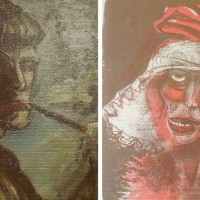-
Germany Takes Steps to Promote Transparency in Gurlitt Case
11/18/2013
 Amid criticism from groups representing Holocaust victims and their heirs and growing international pressure to disclose more information about the cache of art found in the apartment of Cornelius Gurlitt, Germany has announced that it will speed provenance research of the artworks, as well as begin to publish online details about the works.
Amid criticism from groups representing Holocaust victims and their heirs and growing international pressure to disclose more information about the cache of art found in the apartment of Cornelius Gurlitt, Germany has announced that it will speed provenance research of the artworks, as well as begin to publish online details about the works.
Until now, German officials had declined to make a list of the works available to the public, fearing it would prompt fraudulent claims and could violate privacy laws. Ronald Lauder of the World Jewish Congress said that because of the mishandling of the discovery of the art and the subsequent delay in making information available, “valuable time has been wasted.”
In response to this criticism, federal and Bavarian authorities announced they would be forming a task force of at least six provenance researchers to trace the ownership of the works. In an effort to promote transparency, a list of the collection, which is being held at a customs warehouse at an undisclosed location, will be “continuously updated” on www.lostart.de, the website of a government-backed organization that keeps track of cultural property lost or confiscated during World War II.
Thus far, twenty-five paintings are strongly suspected of having been looted by the Nazis. Lostart.de was quickly overloaded with visitors, and for much of the first day the list was available, the site was down. Claimants have already come forward for some of the paintings, including the family of prominent French art dealer Paul Rosenberg, who owned Matisse’s Woman Sitting.
Officials have said that out of the roughly 1,400 works of art, 970 may have been looted by the Nazis. Approximately 590 were possibly seized from Jewish owners, while 380 had been deemed “degenerate art.” At this time, officials have not explained the origins of the other 400 artworks found in Gurlitt’s apartment.
It is still unclear how many of the works Gurlitt’s father Hildebrand, a German art dealer, acquired during the war, and how many he acquired afterwards, before his death in 1956. What is known is that between 1941 and 1944 he was sent to Paris ten times to purchase art for Hitler’s planned Linz Museum, according to a statement Hildebrand provided to U.S. authorities in June 1945. At least eight of the numerous paintings the United States returned to Gurlitt in 1950 are found in an inventory of works that were stored at the Jeu de Paume museum in Paris, which was used as a repository for objects looted from French and Belgian Jews.
As for the fate of this trove, many of the objects most likely legally belong to Cornelius Gurlitt, as while international guidelines are in place to assist in the restitution of works confiscated by museums, no such formal rules exist for those confiscated by individuals. According to a report by the German finance ministry, Gurlitt would not have to return once-confiscated works purchased during the war by his father from museums. Furthermore, the statute of limitations in Germany for art theft before or during World War II expired decades ago. Still, with the gradual publication of the list of works, heirs can begin legal proceedings, and it will ultimately be up to the courts to decide whether the art in question was obtained legally, was stolen, or was purchased under duress.
The Gurlitt case continues to develop as this past Sunday, officials took possession of 22 more works of art from the house of Gurlitt’s brother-in-law, who contacted the police and asked them to take the art because he was concerned about security. Cornelius Gurlitt himself has finally responded to the controversy, sending Der Spiegel a letter asking that his family’s name no longer be mentioned in the magazine. And after much speculation about the whereabouts of Gurlitt, several photographs of him have since been taken, including one of him at the Munich airport. His destination is unknown.
Art Law Blog
